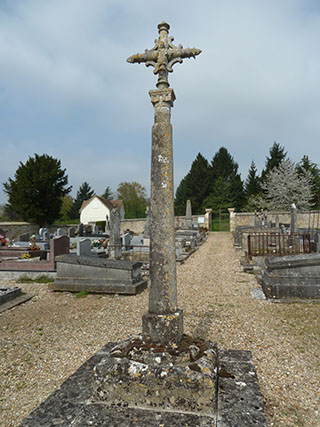Prochain point : lat="49.065826" lon="1.867247"

The Cemetery
A 'hosannière' cross
An ancient cross...
The crosses described as 'hosannière' were funeral monuments built between the tenth and fifteenth centuries; they differ from lanterns of the dead in that they contain no light. The one in Frémainville stands in the centre of the cemetery at the end of the main path. Built entirely of stone, it comprises an approach with a single step up, a pedestal with claw décor and a cylindrical shaft standing 1.67 metres high and topped by a cross with flame-shaped arms. The cross features an image of Christ on one side and a holy bishop giving a blessing on the other. This figure is probably Saint-Clair, who was never actually a bishop but who is often mistaken for his homonym, the first Bishop of Nantes. The pedestal probably dates from the twelfth century and the cross itself from the sixteenth century, as the year 1584 engraved on the shaft attests. It was restored in 1864.
...serving as ossuary
The year 1891, engraved on the base of the shaft, also bears witness to the moving of the cemetery and the role of the cross as ossuary when the graves were transferred.
Traditionally, from the Middle Ages onwards, the dead were buried in the church or in the holy ground around it. The cemetery was at the very heart of village life. However, a royal decree on 6 December 1843 ordered rural communes to transfer the graves outdoors in the wake of hygienist theories about the circulation of air (eighteenth century), the lack of space, insalubrity and a changing attitude towards the dead in the nineteenth century.




